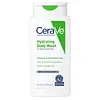What's inside
What's inside
 Key Ingredients
Key Ingredients

 Benefits
Benefits

 Concerns
Concerns

 Ingredients Side-by-side
Ingredients Side-by-side

Water
Skin ConditioningCocamidopropyl Betaine
CleansingPetrolatum
EmollientLauric Acid
CleansingSodium Cocoyl Glycinate
CleansingGlycerin
HumectantGlycine Soja Oil
EmollientUrea
BufferingStearic Acid
CleansingSodium Cocoyl Isethionate
CleansingSodium Hydroxypropyl Starch Phosphate
AbrasiveSodium Lauroamphoacetate
CleansingSodium Methyl Cocoyl Taurate
CleansingSodium Chloride
MaskingCeramide NP
Skin ConditioningCeramide AP
Skin ConditioningCeramide EOP
Skin ConditioningHyaluronic Acid
HumectantPhenoxyethanol
PreservativeGuar Hydroxypropyltrimonium Chloride
Skin ConditioningSodium Hydroxide
BufferingSodium PCA
HumectantOphiopogon Japonicus Root Extract
Skin ConditioningTetrasodium EDTA
Ethylhexylglycerin
Skin ConditioningSodium Lauroyl Lactylate
EmulsifyingPhytosphingosine
Skin ConditioningCholesterol
EmollientCarbomer
Emulsion StabilisingXanthan Gum
EmulsifyingWater, Cocamidopropyl Betaine, Petrolatum, Lauric Acid, Sodium Cocoyl Glycinate, Glycerin, Glycine Soja Oil, Urea, Stearic Acid, Sodium Cocoyl Isethionate, Sodium Hydroxypropyl Starch Phosphate, Sodium Lauroamphoacetate, Sodium Methyl Cocoyl Taurate, Sodium Chloride, Ceramide NP, Ceramide AP, Ceramide EOP, Hyaluronic Acid, Phenoxyethanol, Guar Hydroxypropyltrimonium Chloride, Sodium Hydroxide, Sodium PCA, Ophiopogon Japonicus Root Extract, Tetrasodium EDTA, Ethylhexylglycerin, Sodium Lauroyl Lactylate, Phytosphingosine, Cholesterol, Carbomer, Xanthan Gum
Water
Skin ConditioningSodium Laureth Sulfate
CleansingLauryl Betaine
CleansingPPG-2 Hydroxyethyl Cocamide
EmulsifyingGlycerin
HumectantGlycol Distearate
EmollientParfum
MaskingAllantoin
Skin ConditioningAloe Barbadensis Leaf Juice
Skin ConditioningHelianthus Annuus Seed Oil
EmollientPanthenol
Skin ConditioningCamellia Sinensis Leaf Extract
AntimicrobialTocopherol
AntioxidantTocotrienols
Skin ConditioningTrilinolein
Skin ConditioningTriolein
Skin ConditioningPolyquaternium-7
Polyquaternium-10
Maltodextrin
AbsorbentMethyl Gluceth-20
HumectantSodium Sulfite
PreservativeSodium Benzotriazolyl Butylphenol Sulfonate
UV AbsorberPolysorbate 20
EmulsifyingDisodium Laureth Sulfosuccinate
CleansingButeth-3
SolventTributyl Citrate
SolventSodium Chloride
MaskingMagnesium Chloride
Magnesium Nitrate
Sodium Benzoate
MaskingCitric Acid
BufferingSodium Hydroxide
BufferingDisodium EDTA
Potassium Sorbate
PreservativeMaleic Anhydride
Methylene Di-T-Butylcresol
AntioxidantCaprylyl Glycol
EmollientHexylene Glycol
EmulsifyingPhenoxyethanol
PreservativeBHT
AntioxidantMethylchloroisothiazolinone
PreservativeMethylisothiazolinone
PreservativeWater, Sodium Laureth Sulfate, Lauryl Betaine, PPG-2 Hydroxyethyl Cocamide, Glycerin, Glycol Distearate, Parfum, Allantoin, Aloe Barbadensis Leaf Juice, Helianthus Annuus Seed Oil, Panthenol, Camellia Sinensis Leaf Extract, Tocopherol, Tocotrienols, Trilinolein, Triolein, Polyquaternium-7, Polyquaternium-10, Maltodextrin, Methyl Gluceth-20, Sodium Sulfite, Sodium Benzotriazolyl Butylphenol Sulfonate, Polysorbate 20, Disodium Laureth Sulfosuccinate, Buteth-3, Tributyl Citrate, Sodium Chloride, Magnesium Chloride, Magnesium Nitrate, Sodium Benzoate, Citric Acid, Sodium Hydroxide, Disodium EDTA, Potassium Sorbate, Maleic Anhydride, Methylene Di-T-Butylcresol, Caprylyl Glycol, Hexylene Glycol, Phenoxyethanol, BHT, Methylchloroisothiazolinone, Methylisothiazolinone
 Reviews
Reviews

Ingredients Explained
These ingredients are found in both products.
Ingredients higher up in an ingredient list are typically present in a larger amount.
Glycerin is already naturally found in your skin. It helps moisturize and protect your skin.
A study from 2016 found glycerin to be more effective as a humectant than AHAs and hyaluronic acid.
As a humectant, it helps the skin stay hydrated by pulling moisture to your skin. The low molecular weight of glycerin allows it to pull moisture into the deeper layers of your skin.
Hydrated skin improves your skin barrier; Your skin barrier helps protect against irritants and bacteria.
Glycerin has also been found to have antimicrobial and antiviral properties. Due to these properties, glycerin is often used in wound and burn treatments.
In cosmetics, glycerin is usually derived from plants such as soybean or palm. However, it can also be sourced from animals, such as tallow or animal fat.
This ingredient is organic, colorless, odorless, and non-toxic.
Glycerin is the name for this ingredient in American English. British English uses Glycerol/Glycerine.
Learn more about GlycerinPhenoxyethanol is a preservative that has germicide, antimicrobial, and aromatic properties. Studies show that phenoxyethanol can prevent microbial growth. By itself, it has a scent that is similar to that of a rose.
It's often used in formulations along with Caprylyl Glycol to preserve the shelf life of products.
Chances are, you eat sodium chloride every day. Sodium Chloride is also known as table salt.
This ingredient has many purposes in skincare: thickener, emulsifier, and exfoliator.
You'll most likely find this ingredient in cleansers where it is used to create a gel-like texture. As an emulsifier, it also prevents ingredients from separating.
There is much debate on whether this ingredient is comedogenic. The short answer - comedogenic ratings don't tell the whole story. Learn more about comegodenic ratings here.
The concensus about this ingredient causing acne seems to be divided. Research is needed to understand if this ingredient does cause acne.
Scrubs may use salt as the primary exfoliating ingredient.
Learn more about Sodium ChlorideSodium Hydroxide is also known as lye or caustic soda. It is used to adjust the pH of products; many ingredients require a specific pH to be effective.
In small amounts, sodium hydroxide is considered safe to use. However, large amounts may cause chemical burns due to its high alkaline.
Your skin has a natural pH and acid mantle. This acid mantle helps prevent harmful bacteria from breaking through. The acid mantle also helps keep your skin hydrated.
"Alkaline" refers to a high pH level. A low pH level would be considered acidic.
Learn more about Sodium HydroxideWater. It's the most common cosmetic ingredient of all. You'll usually see it at the top of ingredient lists, meaning that it makes up the largest part of the product.
So why is it so popular? Water most often acts as a solvent - this means that it helps dissolve other ingredients into the formulation.
You'll also recognize water as that liquid we all need to stay alive. If you see this, drink a glass of water. Stay hydrated!
Learn more about Water